A Residential Ventilation System is instrumental in maintaining good indoor air quality by facilitating the continuous exchange of indoor and outdoor air. This process helps to reduce the concentration of harmful particles and excess moisture, creating a healthier living environment. Proper Home Ventilation System is particularly beneficial for individuals with respiratory issues or allergies, as it helps minimise allergens and prevents mould growth.
Understanding these systems’ various types and benefits allows homeowners to make informed decisions to improve air quality and protect against health hazards. By choosing the right system, homeowners can tailor their ventilation needs according to their home’s specific climate and architectural features. This customisation enhances comfort and contributes to energy efficiency, reducing utility costs over time.
Types of Residential Ventilation Systems
Understanding the different types of Residential Ventilation Systems is key to ensuring optimal air quality. The three main types—natural, mechanical, and hybrid—serve distinct purposes and can be selected based on the needs of your property and environmental factors.
Natural Ventilation
Natural ventilation relies on passive airflow through windows, vents, and trickle vents. This method allows fresh air to flow into the home while stale air exits naturally. It’s energy-efficient and ideal for homes in areas with mild climates where frequent airflow is necessary.
Mechanical Ventilation
Mechanical systems use fans, ducts, and vents to control air movement within the home actively. These systems can be categorised into supply, exhaust, and balanced types. Supply ventilation systems push fresh air into the house, exhaust systems remove stale air, and balanced systems do both, providing efficient air distribution for homes that need more control.
Hybrid Ventilation
Hybrid systems combine natural and mechanical methods to achieve an optimal airflow and energy efficiency balance. They are particularly useful in environments with variable weather conditions, providing flexibility and better overall air quality.
Each system has its advantages, and factors such as your home’s size, local climate, and budget will determine the best choice for your needs. A carefully selected system promotes healthy air quality, reducing the risk of respiratory issues and other health concerns.
How Ventilation Systems Reduce Allergens
Effective ventilation systems continuously refresh indoor air by introducing clean outdoor air, which helps significantly lower the concentration of allergens such as dust, pollen, and pet dander. The steady airflow prevents the accumulation of these particles, making indoor spaces more comfortable for allergy sufferers. Mechanical ventilation systems, in particular, often come equipped with high-efficiency particulate air (HEPA) filters that capture even the smallest allergenic particles. This is especially beneficial during pollen seasons when outdoor allergen levels are high.
Additionally, ventilation systems can reduce the presence of volatile organic compounds (VOCs) emitted by household products, which can also act as irritants for those with sensitivities. Ensuring that all living areas receive adequate ventilation can lead to a noticeable reduction in allergic reactions. Regular maintenance of these systems, such as changing filters and cleaning ducts, is essential for maintaining their effectiveness in allergen reduction. By maintaining proper airflow and filtration, ventilation systems create a healthier indoor environment free from common allergens that can trigger respiratory issues.
Role of Home Ventilation System in Preventing Mold
Proper ventilation is crucial in managing indoor moisture levels, significantly reducing mould growth potential. Moisture-prone areas, such as kitchens, bathrooms, and basements, benefit immensely from an effective Home Ventilation System. By ensuring continuous airflow, these systems help dissipate excess humidity that could foster mould proliferation. Ventilation systems with humidity sensors can automatically adjust airflow to maintain optimal moisture levels.
Additionally, adequate ventilation to attics and crawl spaces is essential, as these areas are particularly susceptible to dampness. In colder climates, preventing condensation through consistent ventilation is vital, as condensation can lead to mould issues. Targeted ventilation solutions, such as extractor fans in bathrooms and cooker hoods in kitchens, enhance moisture control. Regular inspection and maintenance of ventilation systems, including cleaning ducts and ensuring unobstructed vents, contribute to their efficacy in mould prevention.
Installation and Maintenance Tips
Proper installation and consistent maintenance are essential to ensure a Residential Ventilation System functions efficiently. Engaging a qualified professional for the installation guarantees that the system is tailored to the home’s layout and specific needs. During installation, attention should be paid to the correct placement of vents and ducts to maximise air distribution and efficiency.
Routine maintenance is vital post-installation. This includes periodic cleaning or replacing filters to prevent blockages and ensure optimal airflow. Inspecting and cleaning ducts regularly is crucial to removing dust or debris accumulating over time. Additionally, it is important to check for any signs of wear and tear in the system’s components, such as fans and motors, and to replace them if necessary.
Humidity sensors and programmable controls can enhance the system’s functionality by automatically adjusting airflow based on indoor conditions. This ensures the ventilation system operates effectively, providing consistent air quality and moisture control. Regular professional inspections can identify potential issues early, preventing costly repairs and extending the system’s lifespan. By adhering to these practices, homeowners can maintain a healthy indoor environment and ensure their ventilation system operates at peak performance.
Why Humidity Control is Essential for Reducing Mold and Allergens
Excessive indoor humidity casts a long shadow over our homes’ health and structural integrity, creating a breeding ground for unwelcome inhabitants like mould and dust mites. Mould flourishes in dampness with its unsightly stains and lingering odours, releasing microscopic spores that, when inhaled, can pose significant health risks, particularly for individuals with respiratory sensitivities. Simultaneously, dust mites, microscopic creatures that thrive in humid environments, leave behind waste products that act as potent allergens, frequently triggering asthma and other respiratory ailments.
A well-designed Residential Ventilation System is a crucial ally in this battle against indoor dampness. Modern systems, often equipped with sophisticated humidity sensors, possess the intelligence to automatically modulate airflow, diligently maintaining optimal moisture levels throughout the home. This proactive regulation effectively disrupts the conditions necessary for mould and allergen proliferation, fostering a healthier living environment.
Areas prone to high moisture generation, such as bathrooms and kitchens, derive particular benefit from targeted ventilation strategies, including installing efficient extractor fans that swiftly remove damp air at its source. Consistent monitoring and diligent maintenance of these ventilation systems are paramount, ensuring their continued efficient operation and promoting a cleaner, healthier, and more comfortable indoor atmosphere for all occupants.
The Link between Home Ventilation and Improved Respiratory Health
Proper home ventilation plays a significant role in enhancing respiratory health by ensuring a continuous flow of fresh air and reducing the concentration of indoor pollutants. Indoor air can harbour numerous contaminants, including dust, pollen, pet dander, and volatile organic compounds (VOCs), irritating the respiratory system. For individuals with asthma or other respiratory conditions, these pollutants can exacerbate symptoms and lead to more frequent health issues. By facilitating the exchange of stale indoor air with clean outdoor air, ventilation systems help to dilute and remove these harmful particles.
Additionally, good ventilation helps to control indoor humidity levels, preventing the growth of mould and dust mites, both of which can trigger allergic reactions and respiratory problems. Advanced ventilation systems with high-efficiency particulate air (HEPA) filters can capture even the smallest airborne particles, providing extra protection for sensitive individuals.
Maintaining regular airflow throughout the home ensures that areas prone to moisture, such as bathrooms and kitchens, do not become breeding grounds for mould. By keeping indoor air clean and well-regulated, Residential Ventilation Systems contribute significantly to better respiratory health, reducing the risk of respiratory issues and improving indoor air quality.
How to Optimise Residential Ventilation System for Allergy Relief & Mold Prevention
Proper optimisation of a Residential Ventilation System involves a combination of strategic adjustments and regular maintenance. Ensuring the system is fitted with high-efficiency particulate air (HEPA) filters can significantly enhance its ability to capture allergens such as dust, pollen, and pet dander. Replacing or cleaning these filters periodically is crucial to maintain their effectiveness. Additionally, incorporating humidity sensors into the system allows for automatic adjustments to maintain optimal moisture levels, essential for preventing mould growth.
Positioning vents and ducts correctly is also key to ensuring clean air distribution throughout the home. Installing extractor fans can effectively remove excess humidity in areas prone to moisture, such as bathrooms and kitchens. Regular inspections are essential to check for any blockages or wear and tear in the system’s components. This includes cleaning ducts and ensuring vents are unobstructed.
Advanced systems with programmable controls can further optimise airflow based on indoor conditions, providing targeted relief during high pollen seasons or increased humidity. These strategies ensure the ventilation system operates efficiently, reducing allergens and preventing mould, fostering a healthier living environment.
Choosing the Right Ventilation System to Combat Mold and Allergens
Selecting an appropriate ventilation system is pivotal for effectively managing mould and allergens. Various factors must be considered, including the property’s size, local climate, and the specific health requirements of the occupants. Different systems, such as natural, mechanical, and hybrid ventilation, offer distinct benefits and should be chosen based on individual circumstances.
Consulting with a qualified professional can provide tailored recommendations, ensuring the selected system meets the home’s unique needs. Features like HEPA filters and humidity sensors can further enhance the system’s ability to reduce allergens and prevent mould growth, contributing to a healthier indoor environment.
Conclusion
In conclusion, Home Ventilation System are indispensable tools in the ongoing effort to cultivate healthy indoor environments. By consistently refreshing the air, these systems actively diminish the presence of allergens and regulate humidity levels, thereby hindering mould proliferation. From the basic principles of natural airflow to the sophisticated mechanical and hybrid systems mechanisms, each offers unique advantages tailored to diverse needs and home designs. Proper installation, diligent maintenance, and strategic optimisation, including HEPA filters and humidity controls, are crucial for maximising the effectiveness of these systems.
Frequently Asked Questions
How does a Residential Ventilation System help with allergies?
Residential Ventilation Systems continuously introduce fresh, clean outdoor air while expelling stale, allergen-laden indoor air. Many mechanical systems also incorporate HEPA filters that trap microscopic allergens like dust, pollen, and pet dander, significantly reducing their concentration within the home.
Can a Home Ventilation System prevent mould growth?
Yes, Home Ventilation System plays a vital role in preventing mould. By maintaining consistent airflow, these systems help regulate indoor humidity levels. Excess moisture is a primary catalyst for mould growth, and effective ventilation helps to dissipate this moisture, especially in damp-prone areas like bathrooms and basements.
What are the different types of Residential Ventilation Systems?
The main types are natural ventilation, which relies on passive airflow through windows and vents; mechanical ventilation, which uses fans and ducts to actively control airflow (including supply, exhaust, and balanced systems); and hybrid ventilation, which combines natural and mechanical methods for optimal efficiency.
How often should I maintain my Residential Ventilation System?
Regular maintenance is crucial for optimal performance. This typically includes changing or cleaning filters every 1-3 months, depending on the filter type and air quality. Ducts should be inspected every few years to remove accumulated dust and debris. Annual professional check-ups are also recommended.
Is it worth investing in a Residential Ventilation System?
A Residential Ventilation System is a worthwhile investment for individuals with allergies or respiratory issues and for homeowners concerned about mould growth and overall indoor air quality. It contributes significantly to a healthier living environment, can reduce the frequency of allergic reactions, and helps protect the home’s structural integrity by preventing moisture-related damage.













